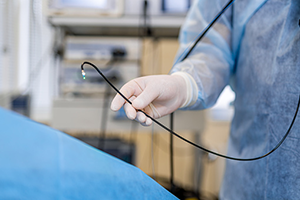Colonoscopies performed with computer-aided detection, or artificial intelligence (AI), saw an increase in the overall rate of detection of adenoma, or cancerous and precancerous polyps, by 27% in average-risk patients, according to new data presented by Shaukat et al at Digestive Disease Week 2022 (Abstract 867b). The results of the prospective, randomized, multicenter study, also published in the journal Gastroenterology, found that when AI was used during a screening colonoscopy, the adenoma per colonoscopy rate increased significantly—by 22%, from 0.82 to 1.05.
This research further suggests that AI can be an efficient tool for gastroenterologists and endoscopists to incorporate into their procedures to reduce the number of polyps missed and left behind in the colon, many of which can be precancerous.
“Our findings add to the growing amount of literature that shows using computer-aided technology during an endoscopy procedure can improve the quality of exams performed and improve outcomes for our patients,” said first study author, clinician-scientist Aasma Shaukat, MD, MPH, the Robert M. and Mary H. Glickman Professor of Medicine and Gastroenterology and Director of Outcomes Research for the Division of Gastroenterology and Hepatology at NYU Grossman School of Medicine. “Several software technologies are currently available for clinicians and incorporating the use of these resources will only enhance the care we provide our patients and improve the quality of exams we as physicians are able to perform.”

Photo credit: Getty
Computer-Aided Colonoscopies
During a colonoscopy, a doctor inserts and threads a narrow, flexible tube called a colonoscope into the rectum and through the entire colon. The colonoscope is equipped with a small camera at its end that allows the doctor to visualize and examine the lining of the colon and rectum as they withdraw the scope. If the physician identifies an abnormal growth or polyp during the procedure, they will remove it and send it to pathology for a definitive diagnosis. While the procedure is effective, results vary depending on the skill of the physician performing the exam, and an estimated 30% of polyps are missed during a traditional procedure. In an effort to improve quality and efficacy, researchers are working with AI platforms to act as a second set of eyes for the endoscopist. A computer-aided detection device was developed for the identification of colorectal polyps during high-definition white-light colonoscopy procedures. The device analyzes the colonoscope video feed in real time and identifies potential polyps and areas of concern on the monitor. The endoscopist can see these areas in real time, thus improving the results of the procedure.
Study Details
For the study, 22 board-certified gastroenterologists performed colonoscopies for 1,440 patients from January 2021 to September 2021. Patients were randomly assigned to receive either a standard colonoscopy or a colonoscopy using computer-aided detection software. All patients included in the study were over the age of 40 and having a screening or surveillance colonoscopy but had not had a previous colonoscopy within the last 3 years. Of the total number of patients, 677 were randomly assigned to the standard arm and 682 to the computer-aided arm. The number of polyps found using a computer-aided colonoscope was 1.05 compared to 0.83. There was no decrease in the true histology rate, indicating the polyps of concern were all removed.
“Colorectal cancer is the second leading cause of cancer-related deaths in the United States, and it is one of the few cancers that can be prevented if caught early,” said Dr. Shaukat. “Our mission remains to improve and enhance the quality and efficacy of the colonoscopy across the board to provide the best care for patients.”
The researchers acknowledge that long-term follow up studies are needed to further evaluate the benefit of computer-assisted devices on clinical outcomes.
Disclosure: The study was funded by Iterative Scopes, Inc. For full disclosures of the study authors, visit gastrojournal.org.

